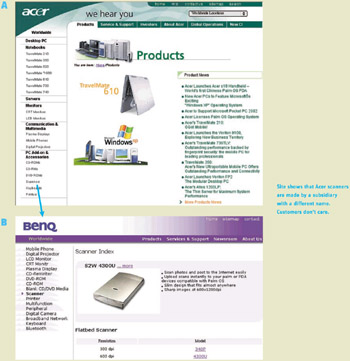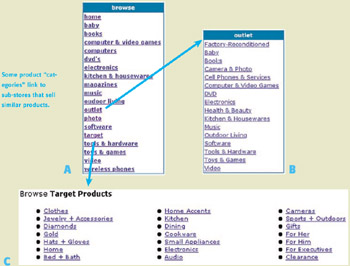Blooper 15: Site Reflects Organizational Chart
| < Day Day Up > |
Blooper 15: Site Reflects Organizational Chart
According to Nielsen (1999), websites that reflect a company or agency's organizational chart are "a common mistake." I would strengthen that to "very common." Not only is it common, it is a disaster for a site's navigability and usability.
When a business or agency's organizational structure or history influence the design of its website, it is difficult for people to find what they are seeking or do what they want to do. It makes the site seem arbitrary, ad hoc, and nonsensical . It impedes learning, retention, navigation, you name it. In fact, this blooper is a significant cause of the chaotic categorization schemes discussed in Chapter 1 (see Blooper 2: Confusing Classifications).
Visitors to a website don't care how your company is structured or which division, department, development team, or developer was responsible for each part of the site. They bring their own goals to a website and don't care about your organization's goals and history.
Let's look at some websites where the company's organization seems to have intruded into the site, detracting from users' ability to accomplish their goals.
Am I Still at the Same Company?
In Chapter 1, I showed that different parts of Acer.com disagree on what scanners Acer sells (see Blooper 4: Conflicting Content). That blooper is related to the "organizational chart" blooper: Different suborganizations are responsible for the different part of Acer's site. Acer also commits the "organizational chart" blooper in another way: Its site shows that some of its product "divisions" are distinct corporate entities, with distinct names , logos, and site designs.
For example, the part of Acer that makes scanners recently reorganized as a subsidiary company called Benq. Clicking on "scanners" from Acer's main product page drops would-be customers onto Benq's scanner page, making them wonder whether (1) they are still at Acer and (2) these are Acer products (Figure 3.1).

Figure 3.1: www.Acer.com (Dec. 2001)-Site reflects that Acer's scanner maker is Benq. A- Acer's Product page. B- Benq's Scanner page.
I Just Want a Camera!
Imagine that you go to zBuyer.com, shopping for a cheap camera. You look at zBuyer's product categories (Figure 3.2[A]), and see "photo." Good. But wait ... what's this "outlet" just above it? "Outlet" usually means discount prices, so maybe you should look there. And what's this "Target" link below it? You were just in a Target store yesterday , looking at cameras . Is this a link to their website, or what? Clicking around, you learn that zBuyer has a special outlet store, whose product categories are virtually identical to zBuyer's (Figure 3.2[B]). After more clicking, you discover that zBuyer apparently has a deal with Target stores to sell products for them, and that Target's product categories overlap with zBuyer's (Figure 3.2[c]). So now you know zBuyer has an outlet subsidiary and is partnered with Target, but you don't yet know where on this site to get the best price on a camera. And it looks as if it's going to take time and work to find out. You've just been hit by the "organizational chart" blooper.

Figure 3.2: www.zBuyer.com (Feb. 2002)-Site shows organization chart. A- zBuyer's product categories include "Outlet" and "Target." B- Outlet categories are very similar to zBuyer's. ( c ) Target's categories overlap with zBuyer's.
Use Our Support! No, Use Ours!
An example from Silicon Graphics' customer service home page shows how offerings from different internal organizations can appear to compete for customers' attention and business, thereby confusing customers. The page formerly had three links for customer support: Support Services, Online Support, and SupportFolio Online (Figure 3.3). Two of those offered "online" support. Furthermore, SupportFolio Online offered "patches," whereas Online Support offered "security patches." If someone wanted customer support, what should they choose? (See Chapter 1, Blooper 3: Unhelpful Descriptions.) It seems clear-to an outsider anyway-that different organizations were behind these competing offerings. The site was recently upgraded, reducing-but not eliminating-evidence of Silicon Graphics' organizational chart.

Figure 3.3: www.SGI.com (Jan. 2002)-Customer service page has offerings that seem to compete with each other.
Avoiding the Blooper
Websites and Web applications should be organized according to the needs of their intended users. What do users want to do at the site? This means
-
Devoting resources up-front, before coding, to interviewing prospective users (Brinck, Gergle, and Wood, 2001)
-
Watching them use previous versions of the planned site or competitor sites
-
Getting their reactions to paper or online mock-ups of the site
-
Designing the site to reflect user tasks , not organizational fiefdoms
Unfortunately, unlike many of the other bloopers discussed in this book, this one is hard to avoid. Organizations do have structure; they do have suborganizations. Each suborganization has its own responsibilities. Nonetheless, it is very important to avoid this blooper. As Nielsen (1999) points out:
Admittedly, it is easiest to distribute responsibility for the site to divisions and departments ... but doing so results in an internally centered site rather than a customer-focused site.
Put the Web Team at the Corporate or Agency Level
Giving responsibility for developing different parts of your external website to different suborganizations is a recipe for a site that commits this blooper. Instead, create a Web team that serves at a corporate- or agency-wide level. This team would gather requirements, information, and content from various suborganizations and integrate these to produce a coherent , unified website.
Furthermore, the Web team should be given responsibility for the entire external site. The product sales, customer support, and company information sections should not be "balkanized" into separate organizations; otherwise , the site will reflect that balkanization.
Intranets are an exception. It probably makes sense for a company's internal website and collection of Web-based applications to be designed and managed by a different group than that responsible for the external site. On the other hand, it also makes sense for the intranet to be a company- or agency-wide function so employees won't have to struggle with the negative effects of intranet-Web balkanization.
Links to Other Sites
The whole point of the Web is to link to information that might be useful, wherever it might be. Indeed, the distinction between pages that are "in" and "not in" a particular site is fuzzy: Isn't anything a site links to "in" that site? Not exactly.
All pages within a site should have a consistent appearance. Users should be able to tell instantly whether they've left a site by whether the appearance of the pages has changed or whether the new page appears in a new browser window. [1] Pages in a site should provide any information or functionality that users must have to use the site successfully. External links should be strictly for auxiliary information and functionality. If information necessary to operate a site successfully is provided on another site, it should be incorporated into the first site with permission, of course.
Test Your Site against These Criteria
As a site is developed or upgraded, its managers and architects should beware of organizational artifacts sneaking in. Such artifacts should be eradicated before becoming entrenched. Site architects , managers, and even top executives should ask these questions (with the right answers in parentheses):
-
Does the site organization make sense to people who don't know the company's organizational chart? (Yes)
-
Can users deduce significant aspects of your organizational structure by examining the site? (No)
-
Have all traces of "dirty laundry"-such as the fact that different divisions developed similar products-been eradicated? (Yes)
-
Are there subsites that exist only because there is-or was-an internal organization corresponding to them? (No)
-
Have pages or sections inherited from legacy sites been updated to fit seamlessly into the new site? (Yes)
-
Is content consistent throughout the site? (Yes)
-
Is there conflicting information resulting from cross-organizational miscommunication or conflicting sub-organization goals? (No)
-
Can users tell clearly which linked pages are internal or external to the site? (Yes)
-
Do all internal pages follow the same conventions and guidelines? (Yes)
By continually asking these questions and working to make the answers the right ones, those responsible for the success of a website can help fend off creeping balkanization.
Applying the Criteria to the Examples
If the three websites given as examples of the "organizational chart" blooper were evaluated against the criteria and then improved so as to give the right answers, the following changes would result:
-
Acer. Visitors to Acer's website would see all products offered by Acer presented as Acer products, on pages designed to fit into Acer's website. Visitors to subsidiary sites such as Benq would see that subsidiary's products presented as its own.
-
zBuyer. The "Outlet" and "Target" pseudo-categories would be eliminated. Clicking on a category such as "camera" would provide access to all products in that category, regardless of which store offers it. If the store matters from a customer's point of view, it could be indicated either by subcategories on product category pages or by marking individual products.
-
Silicon Graphics Incorporated. There would be one offering for customer support services. Going to its page might display various options, with clear explanations to allow customers to choose what they need. All patches-security or not-would be available from one place.
[1] A convention is emerging that offsite links bring up a new browser window, but it is not yet widely followed.
| < Day Day Up > |
EAN: 2147483647
Pages: 128